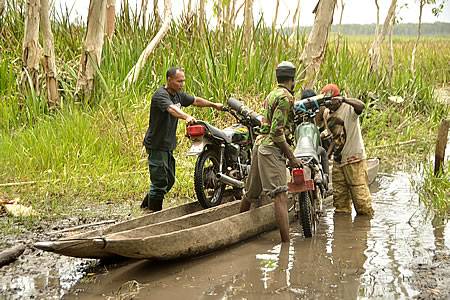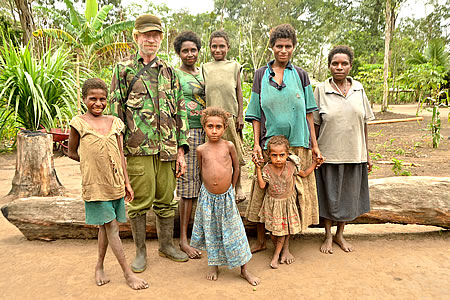English | Dutch |
|
| Wasur NP: a perfect Papuan experience | |
Merauke (Indonesia), September 6th 2012
|
|
| |
|
It is already a long standing dream to visit Papua. We were one time in Papua before, in 2009, when we only visited the Arfak Mountains near the city of Manokwari (see also a photo-impression and short video about our visit to Arfak). In 2012 we decided to visit the Indonesian province again, just to experience a little bit more of this mysterious part of the world. Vast jungles, picture perfect villages and of course the Birds of Paradise, is what always attracted us. Many people still think about men with penis sheaths when they hear about Papua, but the time that ‘normal’ men in Papua wore the penis sheaths is behind us. Of course, you still see them in the Baliem valley, but almost all of these men wear them to be an attraction for tourists and hope for a paid-for picture. There are also many festivals in Papua where you can see traditional cloths, and in some touristy places you can even book a private traditional dance, including all the ‘traditional’ stuff. Almost all travellers who travel to Papua visit the Baliem Valley. This huge valley in where the city of Wamena is located, and which can only be reached by plane, is seen as the cultural and tourist heart of Papua. The beautiful valley is bounded by high mountains and it was as recent as 1938 when the first white man reached the area. Till that time the Baliem area was still a place where the Stone Age was present. The only tools they had were made of stone, bones or wood. The travellers and tourists that visited the area since then did bring a lot of changes for the Dani tribe. They adopted modern techniques and nowadays the valley is traversed by motorcycles, minivans and expensive jeeps. The Baliem valley isn’t a cheap destination. If you want to slip away from the ‘civilized world’ and see something of the traditional Papua, you have to spend a significant amount of money. And that is what you want, because Wamena and its direct vicinity isn’t really a nice place to be. The area is infamous for wannabe guides who hassle tourists, in the hope to be hired as guide for treks in the area. In that sense, the Baliem valley isn’t unfortunately the authentic and traditional destination anymore. |
|
 |
|
Two motorcycles and six people easily fit on two traditional canoes |
|
With this in mind we did some thinking about an alternative destination to find the authentic and traditional Papua. We eventually decided to head for the Wasur National Park (Wasur NP), in South Papua, between the city of Merauke and the border of Papua New Guinea. Wasur NP is only visited by a handful of travellers, and most of them are birdwatchers in search of a few species of the Birds of Paradise and the Southern Cassowary. But Wasur NP has more to offer. The landscape is beautiful and diverse, with huge areas of Monsoon Forest, Savannah and Paper bark Forest. But Wasur NP is also home to many little villages of different tribes, in where people still live a very traditional and authentic life. Long before the national park was established, people of different tribes inhabited the area and used the products found in the forest to survive. The communities are still allowed to live within the park borders, but some conditions apply. They are only allowed to ‘use’ the forest for their own needs and are only allowed to use traditional agricultural and hunting techniques, like knives, spears and bow and arrow. In this way the national park authorities hope to keep the balance in the park. In reality however, we saw local people roaming the forest with guns, which can hardly be described as a traditional hunting method. We got in touch with Pak Amin, one of the senior park rangers of Wasur. We discussed our plans and he was happy to guide us through the park, together with a colleague of him (Pak La Hisa). He advised us to focus our visit on the area around a little community called Yakiu, in the far eastern part of the park and only 500 metres away from the Papua New Guinea border. This seldom visited part of the park with good forest is the home of three different species of Birds of Paradise, which we all three saw. But it is not really easy and cheap to reach Yakiu. We used the first day to travel by motorcycle to the little village of Rawa Biru where we spent the night. We also bought here some last supplies (also some supplies as present for the people of Yakiu), because it was the last opportunity. We arranged with mr Marwan, the village head of Rawa Biru, also the logistic issues of our trip to Yakiu. Just behind Rawa Biru we have to cross a lake, for which we needed the help of mr Marwan. He arranged two traditional canoes which were bound together to create a more stable ‘vessel’. We used this small boat not only to transport us across the lake, but also one motorcycle and a driver, to bring our luggage and supplies to Yakiu. From the other side of the lake, it is an additional 30 kilometres to Yakiu, which we did on foot, in a long 7 hours walk (with some bird watching on the way; we even saw a wallaby). | |
 |
|
The friendly and hospitable Lodis family in Yakiu |
|
| When we eventually reach the village of Yakiu, we have the feeling that we enter an open air museum. We have heard and read several times before about the ‘Garden of Eden’, but we were never able to get a real visualisation of it, but if we have to make one, it must be something like Yakiu. Yakiu is located in an open area in the forest, on where sixteen families made wooden shelters surrounded by beautiful well-kept gardens in where they grow cassava, pumpkins, bananas, chillies and some kind of a sugar cane. The open area is surrounded by high trees in where Cockatoos, Parrots and Manucodes (a Bird of Paradise) whistle to let us know that they are part of this incredible paradise. As soon as we arrive in the village, women and children leave their shelters to come and see who the new visitors are. Men are not present; they are working in the fields and forest. The women and children sit down on the ground in front of us, and we are soon after surprised to hear that they speak English. They used to live in Papua New Guinea (where they speak English) and decided a year ago to cross the border to Indonesia to built up a new life here. It is great to have the possibility to communicate with these people directly.
The three following days we are the guests of mr Lodis, the village head. It is his duty to accommodate us and to take care of us. We brought our own food, but the family was kind enough to cook it for us. We got the best place in their shelter to sleep, while the family took a place on the ground. During the day, mr Lodis guided us through the forest and brought us to the best places, including the displaying tree of the Raggiana Bird of Paradise. We discussed with mr Lodis about the need to conserve the birds. And he was aware of that. He also knows that colourful birds in general are heavily hunted for in Papua, and that he has ‘gold’ in hands, in the form of tourist money, when he manages to keep a sustainable population of the Birds of Paradise, Lories, Parrots, Lorikeets, Cockatoos, etc. We have a special time in Yakiu. We see beautiful birds, picture perfect landscapes and we had the rare opportunity to live very close with a traditional and authentic Papuan family for three days. These people are the prove that even without almost nothing (no electricity, no running water, no toilet, no shoes, no house, no privacy, no medical facilities and no school), you can still have a satisfied life. Almost all the things they need can be found in the forest, caught in the swamp or grown on their little fields. There are only a few things that they buy from other villages, like sugar, salt, coffee, cloths and especially cigarettes and beetle nut. After some very special days we travel back to the ‘civilized’ world, in the form of the village Rawa Biru with its limited facilities. We take a shower in the house of the village head and continue by motorcycle to the forest of Yanggandur, a good place in Wasur NP to see the Southern Cassowary and the Southern Crowned-Pigeon. We saw the first one but missed the latter. But still, it was a tremendous visit to an area that has a lot to offer. We got a Papuan experience we will never forget! --------------------------------------------------------------------------------------------------------------------------------------------------------------- Useful contacts for planning/organising any trip to Wasur NP: For any questions about visiting the park, please contact us. | |